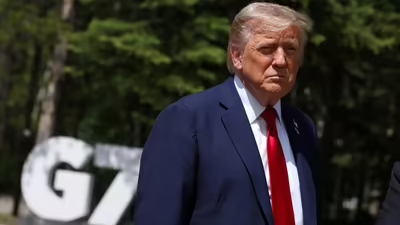BREAKING NEWS: Middle East Crisis 2025 – Israel-Iran Conflict Escalates as Trump Leaves G7 Early
Tags:
-
Middle East Crisis 2025
-
Israel Iran Conflict 2025
-
Donald Trump G7 Exit
-
Tehran Evacuation
-
Israeli Airstrikes on Iran
-
Iran Retaliation
-
G7 Summit Crisis
-
Geopolitical Tensions 2025
-
Nuclear Diplomacy 2025
-
Humanitarian Crisis Middle East
-
Oil Price Surge 2025
-
Global Financial Markets Impact
-
US Foreign Policy Trump
-
Proxy Wars in Middle East
-
Live Updates Middle East Conflict
In an unprecedented turn of events, the Middle East Crisis 2025 has erupted, shaking global geopolitics as Israel and Iran plunge into open conflict. Former U.S. President Donald Trump has dramatically exited the G7 summit amid escalating hostilities, issuing a stark warning: “Everyone should immediately evacuate Tehran.”
The Spark That Ignited the Middle East Crisis 2025
On June 13, 2025, Israel launched precise airstrikes on Iranian nuclear and military facilities across Tehran and other strategic regions. Israeli officials stated these strikes aimed to preempt imminent threats from Iran’s nuclear ambitions and proxy forces.
The Iranian response was swift and severe, launching missile and drone assaults on Israeli military installations and populated areas. So far, over 224 Iranians and 24 Israelis have perished, with mass evacuations underway, including a full-scale Tehran evacuation urged by the Iranian government.
Trump’s Dramatic G7 Exit Amid Middle East Crisis 2025
While attending the G7 summit in Kananaskis, Canada, Trump shocked global leaders by abruptly leaving. His G7 summit crisis exit signaled America’s intensifying focus on the conflict. Speaking to reporters, Trump stated:
“This is not about a ceasefire. It’s about something much bigger. We will not allow Iranian aggression to spark global chaos.”
G7 Leaders Respond to Middle East Crisis 2025
The G7 issued a joint statement condemning Iran’s destabilizing activities while reaffirming Israel’s right to self-defense. Behind closed doors, fierce debates unfolded over the statement’s tone. Trump initially demanded stronger language against Iran before finally agreeing to a compromise.
The Worsening Humanitarian Crisis in Middle East 2025
The Middle East Crisis 2025 has sparked a severe humanitarian emergency. Tehran’s international airport remains closed, healthcare systems are overwhelmed, and UN organizations are struggling to deliver aid. Countries like India are already evacuating their nationals amid fears of further escalation.
Geopolitical Implications of the Middle East Crisis 2025
This crisis stems from decades of hostilities. Israel accuses Iran of funding proxy groups such as Hezbollah and Hamas, while Iran views Israel’s nuclear capabilities and U.S. backing as existential threats. Trump’s intervention may signify a U.S. foreign policy shift towards more aggressive Middle Eastern engagement.
Potential for Nuclear Diplomacy Amid Crisis
Despite rising hostilities, backchannel diplomatic efforts are quietly emerging. Arab intermediaries are attempting to bring Iran and the U.S. to the table. Iran has conditionally expressed willingness to negotiate if its regional security concerns are addressed.
Global Powers Weigh In On Middle East Crisis 2025
China and Russia have urged restraint, criticizing Israeli aggression while warning of broader destabilization. The European Union is calling for urgent de-escalation to prevent spillover effects across Europe.
Economic Fallout of Middle East Crisis 2025
The global economy is reacting sharply to the Middle East Crisis 2025. Oil prices surged over 10% as fears grew over Persian Gulf shipping disruptions. Financial markets are volatile, with defense sector stocks climbing while broader indexes falter.
Major airlines have canceled flights over the region. Shipping routes through the Strait of Hormuz—a critical oil chokepoint—are being reassessed, adding to global market jitters.
Social Media’s Role in the Middle East Crisis 2025
The conflict has sparked an online information war. Governments are using social media to rally support and control narratives. Trump’s Truth Social post about Tehran’s evacuation went viral, fueling global debates with hashtags like #TehranEvacuation, #IsraelIranWar, and #G7Crisis.
Possible Scenarios for Middle East Crisis 2025
1. Immediate Ceasefire
Global pressure may lead to a temporary ceasefire, facilitated by intense multilateral diplomacy involving the U.S., EU, Russia, and Gulf states.
2. Full-Scale Regional War
If diplomacy fails, a wider regional war could erupt, drawing in Hezbollah, Syria, Iraq, Saudi Arabia, and others—risking catastrophic consequences.
3. Renewed Nuclear Negotiations
Trump’s aggressive approach might be aimed at forcing Iran back to the negotiating table under tougher conditions.
4. Long-Term Proxy Warfare
Even if open war subsides, proxy conflicts may continue via cyberattacks, covert operations, and destabilization campaigns.
Conclusion: Middle East Crisis 2025 — A Global Flashpoint
The Middle East Crisis 2025 represents one of the most dangerous geopolitical flashpoints in recent history. Trump’s involvement underscores the stakes as global leaders scramble to contain the conflict.
Decisions made in the coming days will shape not only the Middle East but global stability for years. The world watches nervously as the situation teeters between diplomacy and disaster.
Related External Resources:
Internal Resources:
SEO Keywords: Middle East Crisis 2025, Israel Iran conflict, Donald Trump G7 exit, Tehran evacuation, Israeli airstrikes, Iran retaliation, G7 summit crisis, geopolitical tensions, nuclear diplomacy, humanitarian crisis, oil price surge, financial markets, US foreign policy, proxy wars, live updates.
